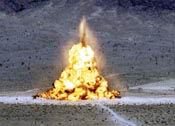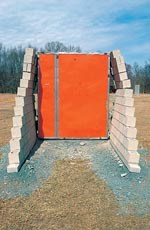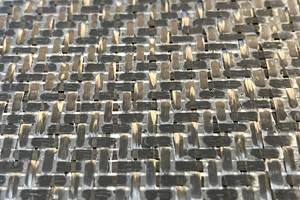Blast protection for large structures
Hardening of public buildings against terrorist threats represents a potentially huge market for antiballistic composites.
In the wake of the Sept. 11, 2001 terrorist attacks in the U.S., security systems of all types continue to be in great demand. The already well-established body armor market took a large turn upward, both in military and civilian law-enforcement applications, as security forces the world over retooled policy and equipment to meet the new threat. Publicity surrounding the lack of armor on many military ground vehicles used in current U.S. military operations in Iraq has spurred significant activity in both lightweight add-on composite armor kits for fielded vehicles and "up-armoring" strategies, in which composite armor is designed into new vehicles and installed on the assembly line (see "Composites on the Frontlines," HPC January 2005, p. 26). On the home front, however, buildings and other critical structures also are being hardened to protect against blast damage. Composites are a key component of blast hardening and, owing to the sheer size of the structures for which protection must be provided, present a large and significant potential market for a unique class of retrofittable antiballistic and blast-containment materials.
One new product is a blast-resistant panel called LIFE SHIELD, developed by B & H Coatings Inc. (Salisbury, Md.), made from a nonwoven reinforcing fiber grid in a matrix of polyurea. The fiber grid, a MeC-GRID product, is manufactured by TechFab LLC (Anderson, S.C.), a spinoff of Hexcel Schwebel, using Twaron, Technora and Technora-hybrid fibers manufactured by Teijin Twaron BV (Arnhem, The Netherlands). Twaron is the company's standard para-aramid fiber and, along with Kevlar from Dupont Advanced Fiber Systems (Richmond, Va.), represents one of the most commonly used fibers in antiballistic applications. Technora is Teijin's unique para-aramid variant, which possesses higher tensile strength and greater elongation than the standard fiber, at an equivalent density.
TechFab makes the grid in a proprietary process that aligns warp and weft fibers wet out with a urethane coating in an open mesh structure, which is then cured. The coating is compatible with the spray-applied Sherwin-Williams General Polymers (Cleveland, Ohio) polyurea resin, which forms a 90-mil-thick skin on either side of the fiber mesh. The completed modular panels, less than 25.4-mm/1-inch thick, can be mechanically fastened to walls to contain blast effects and prevent fragments from injuring building occupants. The panels have been tested successfully at the U.S. Army's Aberdeen Test Center and are currently installed at an unnamed facility, says developer Bruce Hall.
New homeland security rules are, in some cases, mandating building upgrades. Structural Preservation Systems Inc. (Hanover, Md.), a specialty repair contractor known for its use of fiberglass and carbon composites for concrete repair and rehab, has used Hardwire high-tensile steel wire reinforcement, made by Hardwire LLC (Pocomoke City, Md.), in the hardening of the International Monetary Fund (IMF) facility in Washington, D.C. Essentially ballistic steel in fiber form, Hardwire's steel fibers have already demonstrated excellent performance as blast reinforcements in testing, producing armor at significantly lower weight than steel plates and at a lower cost than most advanced fibers. At a price between that of glass and carbon fiber, Hardwire steel offers high strength and high modulus for situations where the composite doesn't have to be highly drapable and conformable. Hardwire's reinforcing strips for buildings can be applied with urethane, epoxy, polyurea, vinyl ester or cement-based adhesives or coatings without affecting the building's appearance.
Another notable application of a composite material is the Blast-Tamer wall system from General Plastics Manufacturing Co. (Tacoma, Wash.). The system consists of engineered polyurethane foam panels tied together with adhesive joints and aramid fiber cord, with the space between the panels filled with sand. The cellular structure of the 75 mm/3-inch thick, 7 lb/ft3 density foam disrupts blast waves, says General Plastics' Ted Hile. In addition, subsequent crushing of the cells absorbs the blast energy, reducing blast intensity and "brisance," the tendency for a material to shatter. The permanent wall system is already in use by the U.S. Air National Guard at many facilities where explosives are stored, and its tested performance allows up to eight times greater storage capacity for increased efficiency.
Related Content
Film adhesive enables high-temperature bonding
CAMX 2024: Aeroadhere FAE-350-1, Park Aerospace’s curing modified epoxy, offers high toughness with elevated temperature performance when used in primary and secondary aerospace structures.
Read MoreResins, additives, adhesives and 3D printing solutions
CAMX 2023: Arkema’s broad portfolio of products for composites fabricators aim to enhance performance, durability and sustainability.
Read MoreHenkel receives Airbus qualification for European aerospace manufacturing facility
The adhesive company’s Montornès, Spain, plant has been approved as a standard and raw materials supplier for various Airbus platforms, adding to its work in lightweighting, fuel efficiency and automation.
Read MorePontacol thermoplastic adhesive films are well-suited for composite preforms
Copolyester- and copolyamide-based adhesive films eliminate the need for sewing threads or binders when stacking laminates while improving the final part’s mechanical properties.
Read MoreRead Next
VIDEO: High-volume processing for fiberglass components
Cannon Ergos, a company specializing in high-ton presses and equipment for composites fabrication and plastics processing, displayed automotive and industrial components at CAMX 2024.
Read MoreAll-recycled, needle-punched nonwoven CFRP slashes carbon footprint of Formula 2 seat
Dallara and Tenowo collaborate to produce a race-ready Formula 2 seat using recycled carbon fiber, reducing CO2 emissions by 97.5% compared to virgin materials.
Read More“Structured air” TPS safeguards composite structures
Powered by an 85% air/15% pure polyimide aerogel, Blueshift’s novel material system protects structures during transient thermal events from -200°C to beyond 2400°C for rockets, battery boxes and more.
Read More
























